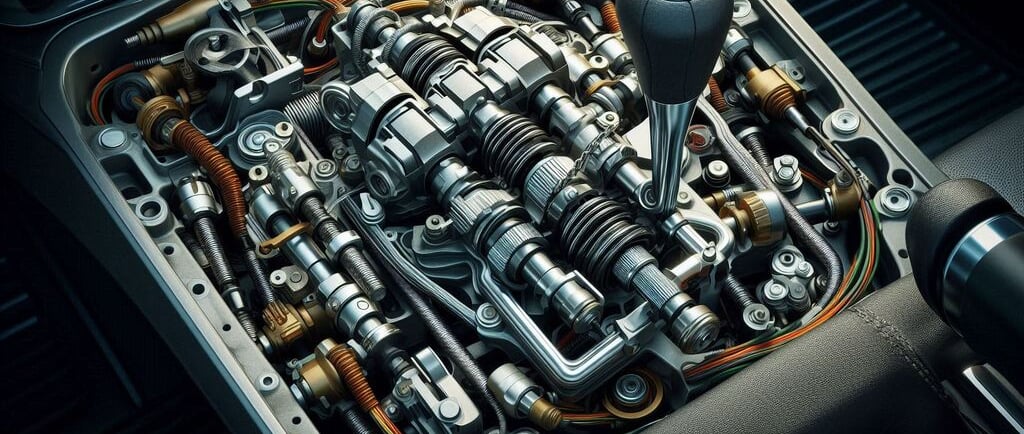Shift Linkage and Shifter: Connects and allows the shifting of gears.
When you drive, you rely on smooth, seamless gear shifts to get from one speed to the next.
TRANSMISSION COMPONENTS
11/12/20244 min read


Understanding the Shift Linkage and Shifter: The Key to Smooth Gear Shifting
When you drive, you rely on smooth, seamless gear shifts to get from one speed to the next. But have you ever wondered how this happens? The magic behind every smooth gear change is thanks to two essential components: the shift linkage and the shifter. These parts are crucial for connecting and controlling the vehicle’s transmission system, enabling you to shift gears effortlessly.
In this article, we’ll dive into how the shift linkage and shifter work together, what can go wrong if they malfunction, and how to keep them in top shape. So, let’s explore the fascinating world of gear shifting!
What is a Shift Linkage?
The shift linkage is a mechanical or hydraulic system that connects the shifter (your gear stick or lever) to the transmission in your vehicle. It acts as a bridge that transmits the force from the shifter to the transmission, allowing you to engage the correct gear. Whether you’re driving a manual or an automatic vehicle, the shift linkage plays a crucial role in the entire shifting process.
Types of Shift Linkages
Shift linkages come in various types, depending on the vehicle and its design. Here are the most common types:
Mechanical Linkages: These consist of rods or cables that physically move the transmission. They offer a direct connection between the shifter and the transmission.
Hydraulic Linkages: In some automatic transmissions, hydraulic linkages are used to shift gears. They use fluid pressure to move the transmission components rather than a mechanical connection.
No matter the type, the shift linkage must be properly aligned and free from wear to ensure the transmission functions smoothly.
The Role of the Shifter
The shifter is the control lever you use to change gears. It may be a traditional stick shift, a console-mounted lever, or a paddle on the steering wheel, depending on the vehicle’s design. The shifter connects to the shift linkage, sending the necessary signals to the transmission to engage the correct gear.
How the Shifter Works
When you move the shifter, it sends a mechanical or electrical signal to the shift linkage. The linkage then adjusts the transmission components to engage the desired gear. For example, in a manual transmission, when you push the shifter into first gear, the linkage ensures that the clutch and gears are engaged correctly.
In automatic transmissions, the process is often more complex but still relies on the shift linkage to send the right signals. The shifter might activate solenoids or engage hydraulic systems that control gear selection.
Common Problems with Shift Linkages and Shifters
Like any mechanical system, the shift linkage and shifter can experience wear and tear over time. Here are a few common problems:
1. Sluggish or Stiff Shifting
If the gear shifts feel stiff or slow, it might indicate a problem with the shift linkage. Dirt, rust, or lack of lubrication can cause the linkage to become stiff, making it harder to engage gears smoothly.
2. Difficulty Switching Gears
When it becomes hard to move the shifter into a particular gear, it could mean the linkage is misaligned or the transmission is experiencing an internal issue. Sometimes, loose or worn-out linkage cables can cause this problem.
3. Unusual Noises
Strange noises during shifting—such as grinding or clunking—might indicate that the shift linkage is not properly adjusted. In such cases, the gear might not fully engage, which could lead to transmission damage if not addressed.
Maintenance Tips for the Shift Linkage and Shifter
Proper maintenance of the shift linkage and shifter system can prevent many issues from arising. Here are some practical tips to keep them functioning smoothly:
Regular Inspection
Inspect the shift linkage and shifter for visible signs of wear, such as loose components or damaged cables. Catching small problems early can save you from more costly repairs down the road.
Lubrication
Regularly lubricate the shift linkage to prevent rust and corrosion. This simple step can ensure smooth gear shifting, especially if you live in an area with extreme weather conditions.
Keep the Shifter Clean
The shifter can collect dust and grime over time. Keeping it clean will prevent these particles from entering the linkage and causing unnecessary friction.
Seek Professional Help
If you notice issues like grinding or difficulty shifting gears, it’s best to have a professional mechanic inspect the shift linkage and shifter. These problems could indicate a more complex issue within the transmission system.
Why Shift Linkage and Shifters Matter for Your Vehicle’s Performance
A well-maintained shift linkage and shifter are essential for vehicle performance. Poor shifting can result in a jerky ride, reduced fuel efficiency, and even damage to your transmission. A smooth, responsive shifting system not only improves your driving experience but also extends the lifespan of your transmission.
Real-World Example: How Shift Linkage Affects Performance
Imagine driving on a busy highway, trying to make quick shifts to accelerate or decelerate. If your shift linkage isn’t working well, every gear change could feel sluggish or delayed. This makes your car less responsive, causing frustration and potentially compromising your safety.
By ensuring that the shift linkage and shifter are in good working condition, you can enjoy a more efficient, safe, and comfortable ride.
Conclusion: Keep Your Shift Linkage and Shifter in Top Shape
The shift linkage and shifter are integral parts of your vehicle’s transmission system, directly impacting the smoothness of your gear shifts. Regular maintenance, including lubrication and inspection, can prevent many common issues, ensuring that your car shifts smoothly for years to come.
If you’re experiencing problems with shifting, don’t hesitate to consult a professional. Taking care of these components will not only enhance your driving experience but also help protect your transmission.



